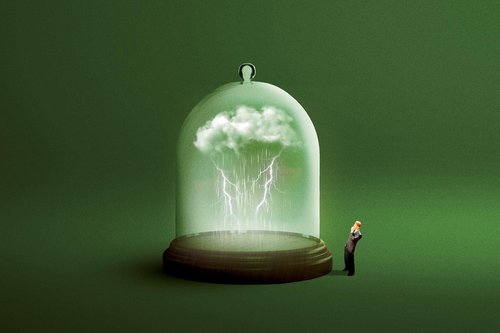
I’m so distracted at work,” Jesse lamented one day. He was slumped on my couch, looking utterly defeated. “I can’t focus on anything.”
“Why?” I asked.

Image Credit: Nicolás Ortega

“We’re in a recession! Have you heard about all the layoffs at startups and tech companies lately?”
“You’re worried that will happen to your company?” I asked.
“In the last recession I had to lay off 25% of my workforce, and the business never recovered profitability. This is absolutely happening to me all over again.”
As a psychologist, I often watch my clients grapple with fear. In cognitive-behavioral therapy (CBT), we teach that thinking errors happen in the gaps between a fear-driven thought about a situation and the reality of the situation itself. These thoughts project a negative, inaccurate account that the person believes is true. The core of CBT is a set of techniques — reality checks, if you will — to correct these thinking errors as they arise. Here are two major types of thinking errors to look out for.
1. “Negative forecasting,” or “fortune-telling,” is when you expect terrible things to happen. In Jesse’s case, “This is absolutely happening to me all over again” is a textbook example. Jesse’s belief that his company will inevitably fail is interfering with his ability to work efficiently — which becomes a self-fulfilling prophecy. Ruminating disproportionately on these faulty negative assumptions could easily set Jesse on the path to existential despair. Jesse needs to work on sitting with the discomfort of the unknown.
2. Jesse’s conviction that the failure of his company is a foregone conclusion, based on past experiences, is called “all-or-none thinking.“ Notice if you find yourself using superlatives — words like always, never, best, or worst — to frame your thinking, describe yourself, or explain your situation to yourself or a third party. All-or-none thinking negates the gray area where life is lived. To balance his worry, “This is absolutely happening to me all over again,” Jesse should ask: “Do I have the evidence to convince a jury of my peers?” Just because Jesse’s business failed before isn’t enough to convince a jury that history will repeat itself. It assumes Jesse learned nothing from his past missteps.
Snap out of it
To challenge thinking errors, try a simple thought-stopping technique. Put a rubber band around your wrist, and when you catch a habitual thinking error, snap the rubber band gently, tell yourself to stop, and distract yourself with a more pleasant thought. Often, the key to snapping out of fearful thought patterns is to ground ourselves in our bodies and surroundings, which underscores the fact that we exist outside of whatever is going on in our heads. Another mindfulness practice I recommend is adapted from Jon Kabat-Zinn, the professor of medicine who introduced Mindfulness-Based Stress Reduction in the early 1990s. When fear rises:
→ Look around the space you are in (for example, your office).
→ Now, pick five objects. Say the name of each object out loud. For example: stapler, pen, computer, coffee cup, eyeglasses.
→ Repeat this circuit three to five times, deliberately repeating the name of each object while breathing deeply.
→ Scan your body to see if you feel more grounded in space and time. If you are, then your brain should feel clear and your body calm.
→ If you’re not feeling grounded, repeat the process a couple more times.
Fear-driven thinking errors tell your brain a scary story. Only you can change the narrative.
Enjoy Entrepreneur Magazine on your terms. For just $10.99, get 1-year of the print edition delivered straight to your mailbox and 1-year instant access to the digital edition on your mobile device. Subscribe Now!
Comments are closed.
